PLRG1 is an essential regulator of cell proliferation and apoptosis during vertebrate development and tissue homeostasis
- PMID: 19307306
- PMCID: PMC2682009
- DOI: 10.1128/MCB.01807-08
PLRG1 is an essential regulator of cell proliferation and apoptosis during vertebrate development and tissue homeostasis
Abstract
PLRG1, an evolutionarily conserved component of the spliceosome, forms a complex with Pso4/SNEV/Prp19 and the cell division and cycle 5 homolog (CDC5L) that is involved in both pre-mRNA splicing and DNA repair. Here, we show that the inactivation of PLRG1 in mice results in embryonic lethality at 1.5 days postfertilization. Studies of heart- and neuron-specific PLRG1 knockout mice further reveal an essential role of PLRG1 in adult tissue homeostasis and the suppression of apoptosis. PLRG1-deficient mouse embryonic fibroblasts (MEFs) fail to progress through S phase upon serum stimulation and exhibit increased rates of apoptosis. PLRG1 deficiency causes enhanced p53 phosphorylation and stabilization in the presence of increased gamma-H2AX immunoreactivity as an indicator of an activated DNA damage response. p53 downregulation rescues lethality in both PLRG1-deficient MEFs and zebrafish in vivo, showing that apoptosis resulting from PLRG1 deficiency is p53 dependent. Moreover, the deletion of PLRG1 results in the relocation of its interaction partner CDC5L from the nucleus to the cytoplasm without general alterations in pre-mRNA splicing. Taken together, the results of this study identify PLRG1 as a critical nuclear regulator of p53-dependent cell cycle progression and apoptosis during both embryonic development and adult tissue homeostasis.
Figures


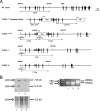
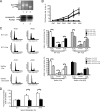
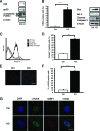
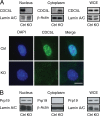
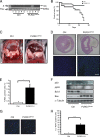

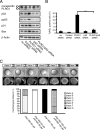
Similar articles
-
Elevated level of PLRG1 is critical for the proliferation and maintenance of genome stability of tumor cells.BMB Rep. 2023 Nov;56(11):612-617. doi: 10.5483/BMBRep.2023-0162. BMB Rep. 2023. PMID: 37817442 Free PMC article.
-
A direct interaction between the carboxyl-terminal region of CDC5L and the WD40 domain of PLRG1 is essential for pre-mRNA splicing.J Biol Chem. 2001 Nov 9;276(45):42370-81. doi: 10.1074/jbc.M105453200. Epub 2001 Sep 5. J Biol Chem. 2001. PMID: 11544257
-
Direct interaction between hnRNP-M and CDC5L/PLRG1 proteins affects alternative splice site choice.EMBO Rep. 2010 Jun;11(6):445-51. doi: 10.1038/embor.2010.64. Epub 2010 May 14. EMBO Rep. 2010. PMID: 20467437 Free PMC article.
-
Early embryonic lethality of mice lacking the essential protein SNEV.Mol Cell Biol. 2007 Apr;27(8):3123-30. doi: 10.1128/MCB.01188-06. Epub 2007 Feb 5. Mol Cell Biol. 2007. PMID: 17283042 Free PMC article.
-
Zebrafish models of p53 functions.Cold Spring Harb Perspect Biol. 2010 Aug;2(8):a001123. doi: 10.1101/cshperspect.a001123. Epub 2010 May 5. Cold Spring Harb Perspect Biol. 2010. PMID: 20679337 Free PMC article. Review.
Cited by
-
Disruption of murine mp29/Syf2/Ntc31 gene results in embryonic lethality with aberrant checkpoint response.PLoS One. 2012;7(3):e33538. doi: 10.1371/journal.pone.0033538. Epub 2012 Mar 20. PLoS One. 2012. PMID: 22448250 Free PMC article.
-
The PSO4 protein complex associates with replication protein A (RPA) and modulates the activation of ataxia telangiectasia-mutated and Rad3-related (ATR).J Biol Chem. 2014 Mar 7;289(10):6619-6626. doi: 10.1074/jbc.M113.543439. Epub 2014 Jan 17. J Biol Chem. 2014. PMID: 24443570 Free PMC article.
-
BCAS2 is essential for Drosophila viability and functions in pre-mRNA splicing.RNA. 2013 Feb;19(2):208-18. doi: 10.1261/rna.034835.112. Epub 2012 Dec 17. RNA. 2013. PMID: 23249746 Free PMC article.
-
The function of spliceosome components in open mitosis.Nucleus. 2010 Nov-Dec;1(6):447-59. doi: 10.4161/nucl.1.6.13328. Epub 2010 Aug 13. Nucleus. 2010. PMID: 21327086 Free PMC article. Review.
-
hPso4/hPrp19: a critical component of DNA repair and DNA damage checkpoint complexes.Oncogene. 2016 May 5;35(18):2279-86. doi: 10.1038/onc.2015.321. Epub 2015 Sep 14. Oncogene. 2016. PMID: 26364595 Review.
References
-
- Agrelo, R., W. H. Cheng, F. Setien, S. Ropero, J. Espada, M. F. Fraga, M. Herranz, M. F. Paz, M. Sanchez-Cespedes, M. J. Artiga, D. Guerrero, A. Castells, C. von Kobbe, V. A. Bohr, and M. Esteller. 2006. Epigenetic inactivation of the premature aging Werner syndrome gene in human cancer. Proc. Natl. Acad. Sci. USA 1038822-8827. - PMC - PubMed
-
- Ajuh, P., J. Sleeman, J. Chusainow, and A. I. Lamond. 2001. A direct interaction between the carboxyl-terminal region of CDC5L and the WD40 domain of PLRG1 is essential for pre-mRNA splicing. J. Biol. Chem. 27642370-42381. - PubMed
Publication types
MeSH terms
Substances
Grants and funding
LinkOut - more resources
Full Text Sources
Other Literature Sources
Molecular Biology Databases
Research Materials
Miscellaneous
